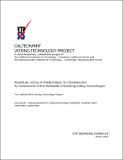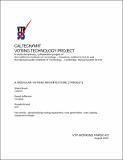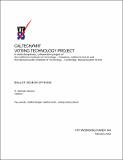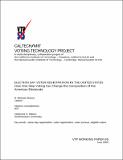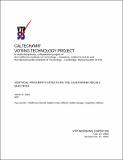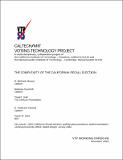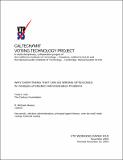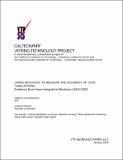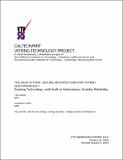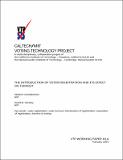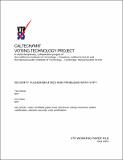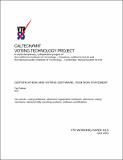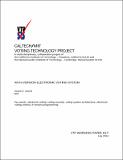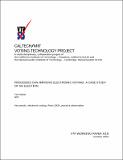Browsing Publications and Working Papers by Issue Date
Now showing items 1-20 of 123
-
Residual Votes Attributable to Technology: An Assessment of the Reliability of Existing Voting Equipment
(Caltech/MIT Voting Technology Project, 2001-03-30)American elections are conducted using a hodge-podge of different voting technologies: paper ballots, lever machines, punch cards, optically scanned ballots, and electronic machines. And the technologies we use change ... -
A Modular Voting Architecture ("Frogs")
(Caltech/MIT Voting Technology Project, 2001-08-18)We present a “modular voting architecture” in which “vote generation” is performed separately from “vote casting.” -
Ballot Design Options
(Caltech/MIT Voting Technology Project, 2002-02-17)Does ballot design “matter”? Does the design of ballots influence how voters cast their ballots, and thereby affect the outcome of an election? -
Election Day Voter Registration in the United States: How One-step Voting Can Change the Composition of the American Electorate
(Caltech/MIT Voting Technology Project, 2002-06)For most Americans, voting requires two steps. First, an eligible citizen must register in some manner with an appropriate government agency. Second, once registered, the citizen can then cast a ballot on or before election ... -
Voting in Massachussetts
(Massachussets Institute of Technology, 2003) -
Who Overvotes, Who Undervotes, Using Punchcards? Evidence from Los Angeles County
(Caltech/MIT Voting Technology Project, 2003-09-09)In this study we examine over- and undervotes from the November 2000 General Election in Los Angeles County. Los Angeles County is the nation's largest election jurisdiction and it used a punchcard voting system in that ... -
Vertical Proximity Effects in the California Recall Election
(Caltech/MIT Voting Technology Project, 2003-10-27)The 2003 California recall election provides a unique opportunity to assess the impact of variations in ballot design and voting methods on the voting accuracy of citizens. Analysis of the results of the California Recall ... -
The Complexity of the California Recall Election
(Caltech/MIT Voting Technology Project, 2003-11-06)The October 7, 2003 California Recall Election strained California’s direct democracy. In recent California politics there has not been a statewide election conducted on such short notice; county election officials were ... -
Why Everything That Can Go Wrong Often Does: An Analysis of Election Administration Problems
(Caltech/MIT Voting Technology Project, 2003-11-26)Before the 2000 presidential election, few citizens in the United States paid much attention to election administration. But scholars have noted that election administration has been a problem for decades. Despite the ... -
Using Recounts to Measure the Accuracy of Vote Tabulations: Evidence from New Hampshire Elections 1946-2002
(Caltech/MIT Voting Technology Project, 2004-01)The 2000 presidential election exposed a surprisingly high level of inaccuracy in the tabulation of ballots. Differences between total vallots cast and votes counted were as high as 19 percent in some counties in Florida, ... -
The SAVE System: Secure Architecture for Voting Electronically: Existing Technology, with Built-in Redundancy, Enables Reliability
(Caltech/MIT Voting Technology Project, 2004-01-04)Existing technology is capable of yielding secure, reliable, and auditable voting systems. This system outlines an architecture based on redundancy at each stage of the ballot submission process that is resistant to external ... -
Where the Good Signatures Are: The Number and Validity Rates of Initiative Petition Signatures Gathered in California Counties
(Caltech/MIT Voting Technology Project, 2004-01-23)One of the biggest hurdles to qualifying an initiative for the ballot is gathering the required number of signatures. Yet little is known about these signatures' representativeness or demographic origin. Using data from ... -
The Introduction of Voter Registration and Its Effect on Turnout
(Caltech/MIT Voting Technology Project, 2004-02)Voter registration, it is widely argued, raises the costs of voting, thereby decreasing turnout. Studies of turnout across states find that states with later registration dates or election day registration have much higher ... -
Whose Absentee Votes Are Counted?
(Caltech/MIT Voting Technology Project, 2004-04)Absentee voting is becoming more prevalent throughout the United States. While there has been some research focused on who votes by absentee ballot, little research has considered another important question about absentee ... -
Security Vulnerabilities and Problems with VVPT
(Caltech/MIT Voting Technology Project, 2004-04)A proposed Voter Verifiable Paper Trail (VVPT) includes a printed ballot as a receipt that a voter can view to verify their vote before leaving an electronic voting machine. This method is also supposed to insure the ... -
Certification and Voting Software: Position Statement
(Caltech/MIT Voting Technology Project, 2004-04-20)Computers are important in every aspect of modern life. Automative tabulating machines are designed to be the most consistent and reliable counting approach invented. Still, questions of reliability, security and auditability ... -
An N-Version Electronic Voting System
(Caltech/MIT Voting Technology Project, 2004-05-20)The ballot battles of the 2000 US Presidential Election clearly indicate that existing voting technologies and processes are not sufficient to guarantee that every eligible voter is granted their right to vote and implicitly ... -
"Voting Technology and Uncounted Votes in the United States"
(Journal of Politics, 2004-08) -
Voting Technology Summary and Report Working Papers
(2004-08-20) -
Processes Can Improve Electronic Voting: A Case Study of An Election
(Caltech/MIT Voting Technology Project, 2004-09-07)Across the United States, I have personally watched hundreds of precincts vote since 2001. Most recently, I traveled to Reno/Sparks, Nevada to observe the rollout of the Sequoia Direct record electronic voting systems with ...
